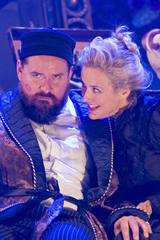| Opera Reviews | 19 April 2024 |
Lightweight diversionsby Sandra Bowdler |
|
| Rameau: Anacréon Vinci: Erighetta e Don Chilone Rameau: Pigmalion Pinchgut Opera June 2017 |
|
|
On the one hand, the French works depict classical myths which are also allegorical: in Anacréon, the intrusion of Love into the temple of Bacchus represents a debate about the compatibility of love and alcohol. Pigmalion tells the story of the sculptor who falls in love with his own creation, an illustration of the power of love. By contrast, Erighetta e Don Chilone is a purely comic story with commedia dell’arte overtones about a youngish widow wanting to remarry an older and rich man, with considerable ribaldry and vulgarity. The Italian musical setting sounds perhaps more frivolous than the stately French style, but the fact is that Vinci is currently being recuperated as one of the more substantial composers of the first third of the 18th century, despite his early demise aged 40 or so. Directed by Crystal Manich, the production envelopes these three pieces in a framing story (pun intended) set in an up-market art gallery, wherein the three performances take place as distractions for the well-heeled clientele. There is some kind of narrative involving a curator, a wealthy donor, his wife … and, to be honest, I found it distracting and didn’t really follow it. It seemed go down well with the audience, and, perhaps this a cheap shot, to be very Sydney. The décor and costumes were all rather white and pastel, in both inner and outer narratives; one might have hoped for a bit more sumptuousness at some point. The costumes in the inner works seemed to waver slightly between 18th century and Victorian. One of the characteristics of French Baroque opera is that it usually contains a lot of dance music. One always hopes for some proper Baroque dancing but it rarely eventuates. The principals and chorus all did their best, but the kind of non-professional dancing on display, often just synchronised swaying, doesn’t really cut it. Musically however Pinchgut always comes up trumps, and this was no exception. Their regular band, the Orchestra of the Antipodes, led by Erin Helyard, played beautifully with grace and subtlety, adapting well to the different styles demanded. The chorus, not the usual Cantillation, but a smaller group called Ensemble, sang well, and blended in the action with four actors. Vocal honours went to the women, led by Opera Australia regular Taryn Fiebig, who played the priestess of Bacchus, Erighetta and the statue, not to mention “an art academic and ex-wife of wealthy donor” in the surrounding tableaux. Her creamy and well-projected soprano was put to good use, especially in Pigmalion where the music seemed to lie right in the best part of her range. Her waspish widow and disguised doctor in Erighetta were a model of buffo singing and comic timing. Young Australian soprano Lauren Zolezzi made a very good impression as Cupid in the first and third works, with a pure silvery voice and delicious trills in “Volez, Amours” in Anacréon. Another young Australian, Morgan Balfour, sang the small role of Céphise with attractively warm tone. Richard Anderson, a bass well known in Sydney, sang the title role in Anacréon as well as Don Chilone, and, like Fiebig, differentiated well the French and Italian styles; his intonation seemed a little insecure at first, but firmed up as the evening progressed, with some excellent singing and acting in the central farce. Haut-contre Samuel Boden was less impressive as Pigmalion, which is rather a soppy role. While this was an evening of somewhat inconsequential bonbons, Pinchgut is, as ever, to be congratulated for bringing unfamiliar repertoire to Australian opera-goers, and lavishing on them top quality musical values.
|
|
| Text ©
Sandra Bowdler Photo © Patrick Boland |
|

 The blending of French and Italian music styles in the early 18th century created “the perfection of music” according to French composer François Couperin (1688-1733). The performance of two works (actes-de-ballet) by the French composer Jean-Philippe Rameau, Anacréon (1757) and Pigmalion (1748) and one, an intermezzo, by the Italian Leonardo Vinci, Erighetta e Don Chilone (1726) allows some comparison of these national styles, although Rameau is of a somewhat later generation and in theory should show the outcome of Couperin’s observation. These are all short and slight pieces, compared with the substantial operatic works of both composers, originally serving as light entertainment between the acts of more serious operas.
The blending of French and Italian music styles in the early 18th century created “the perfection of music” according to French composer François Couperin (1688-1733). The performance of two works (actes-de-ballet) by the French composer Jean-Philippe Rameau, Anacréon (1757) and Pigmalion (1748) and one, an intermezzo, by the Italian Leonardo Vinci, Erighetta e Don Chilone (1726) allows some comparison of these national styles, although Rameau is of a somewhat later generation and in theory should show the outcome of Couperin’s observation. These are all short and slight pieces, compared with the substantial operatic works of both composers, originally serving as light entertainment between the acts of more serious operas.





